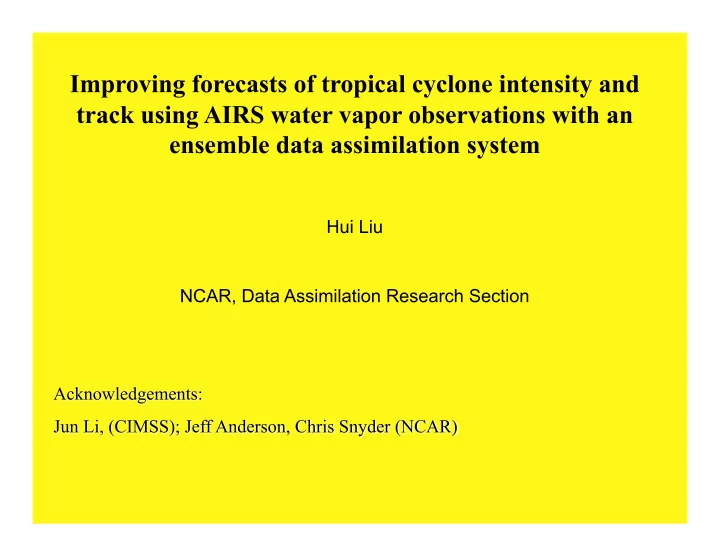

Satellite Water Vapor Data Assimilation Challenges for TC Forecasts Satellite Q data is a major resource of observations available around TC It has been hard for use of Q data to improve TC forecast Highly complicated flow dependent Q forecast error variances and multivariate correlations with T and winds, which are not well understand It is hard to describe the complicated covariance in one static covariance as with traditional data assimilation techniques In NWP centers, large errors are applied for Q data (including rawinsondes)
Ensemble Data Assimilation for TC Forecast Use of short range ensemble forecasts to estimate flow- dependent forecast error Q variance and multivariate covariance Q observations can correct ALL analysis variables consistent with the forecasts, which is vital for making balanced analyses and good forecasts e.g., Water vapor observations impact wind analysis Applied AIRS Q data for hurricane Ike (2008), Ernesto(2006), and Sinlaku (2008)
Super Typhoon Sinlaku (September 8-21, 2008) Formed at 06Z 8 Sept. over W. Pacific; became Super typhoon-4 at 18Z 10 Sept. Interested in if AIRS Q data can improve analyses and forecasts of the initial intensification during 9-11 Sept. AIRS Q Data 2 days before the TC genesis
Daily AIRS Q Data Coverage (Clear sky, September 6-9, 2008)
Assimilation experiments for Sinlaku Use NCAR’s WRF/DART research ensemble data assimilation system Cycling analysis every 2-hours from 00Z 6 to 12Z 9 September Initial ensemble mean conditions from NCEP 1 degree global analysis; initial ensemble generated with 3DVar perturbations Only-Q run : Assimilation of only CIMSS Q soundings FCST run : Ensemble forecasts from the initial conditions; assimilation of no observations Analyses increments of ONLY_Q run demonstrate CLEARLY where Q soundings can provide information of Q, T, and winds.
Daily Analysis Increments (7 Sept. 2008)
Daily Analysis Increments (8 Sept. 2008)
Q Analysis Differences (ONLY_Q – FCST, 700 hPa ) With model’s evolution
Wind Analysis Differences (ONLY_Q – FCST, 700 hPa ) With model’s evolution
Locations of the radiosondes used as validation (6-9, Sept. 2008)
2-hour Forecast Fits to Radiosonde (6-9, Sept. 2008)
Assimilation experiments for Sinlaku(2) CTL run : Assimilate radiosonde, cloud winds, aircraft data, surface pressure data AIRS-Q run : Same as CTL run plus AIRS Q soundings NO artificial TC vortex bogus data is used, which may contaminate impact of real satellite observations The impact of AIRS_Q may be mixed with the impacts from other observation types and less clear Can the addition of AIRS Q observations improve analyses and forecasts?
Q Analysis Differences (AIRS_Q – CTL, 700 hPa )
Wind Analysis Differences (AIRS_Q - CTL, 700 hPa )
Central SLP and Relative Vorticity Analyses (12Z Sept. 2008, after 3.5 days assimilation)
Mean of 36-hour Ensemble Forecasts from 12Z 9 Sept.
Concluding remarks Through the advanced ensemble DA technique, AIRS Q data improve water vapor, temperature, and wind analyses in TC environment; The analysis of TC vortex structure and subsequent forecasts of TC track and intensity are also improved Similar results are obtained for AIRS T profiles Plan to test other water vapor products from AIRS and IASI
Recommend
More recommend